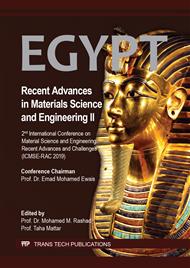[1]
ZHANG, K., YONG, Q., SUN, X., LI, Z., ZHAO, P., & CHEN, S. (2014). Effect of tempering temperature on micro-structure and mechanical properties of high Ti microalloyed directly quenched high strength steel. Acta Metall Sin, 50(8), 913-920.
Google Scholar
[2]
Kheirandish, S., & Noorian, A. (2008). Effect of niobium on microstructure of cast AISI H13 hot work tool steel. Journal of Iron and Steel Research International, 15(4), 61-66.
DOI: 10.1016/s1006-706x(08)60145-4
Google Scholar
[3]
Koneshlou, M., Asl, K. M., & Khomamizadeh, F. (2011). Effect of cryogenic treatment on microstructure, mechanical and wear behaviors of AISI H13 hot work tool steel. Cryogenics, 51(1), 55-61.
DOI: 10.1016/j.cryogenics.2010.11.001
Google Scholar
[4]
Ning, A., Mao, W., Chen, X., Guo, H., & Guo, J. (2017). Precipitation behavior of carbides in H13 hot work die steel and its strengthening during tempering. Metals, 7(3), 70.
DOI: 10.3390/met7030070
Google Scholar
[5]
Hu, X., Li, L., Wu, X., & Zhang, M. (2006). Coarsening behavior of M23C6 carbides after ageing or thermal fatigue in AISI H13 steel with niobium. International Journal of Fatigue, 28(3), 175-182.
DOI: 10.1016/j.ijfatigue.2005.06.042
Google Scholar
[6]
Thelning, Karl-Erik. Steel and its heat treatment. Butterworth-heinemann, (2013).
Google Scholar
[7]
Yeşildal, Ruhi. The Effect of Heat Treatments on the Fatigue Strength of H13 Hot Work Tool Steel., (2018).
DOI: 10.20944/preprints201812.0226.v1
Google Scholar
[8]
Li, T. S., Wang, F. M., Li, C. R., Zhang, G. Q., & Meng, Q. Y. (2015). Carbide evolution in high molybdenum Nb-microalloyed H13 steel during annealing process. Journal of Iron and Steel Research International, 22(4), 330-336.
DOI: 10.1016/s1006-706x(15)30008-x
Google Scholar
[9]
Li, J., Li, J., Shi, C. B., Wang, L. L., Wu, Z., & Wang, H. (2016). Effect of trace magnesium on carbide improvement in H13 steel. Canadian Metallurgical Quarterly, 55(3), 321-327.
DOI: 10.1179/1879139515y.0000000030
Google Scholar
[10]
Li, Shaoying, et al. Carbide Precipitation during Tempering and Its Effect on the Wear Loss of a High-Carbon 8 Mass% Cr Tool Steel., Materials 11.12 (2018): 2491.
DOI: 10.3390/ma11122491
Google Scholar
[11]
Wang, H., Li, J., Shi, C. B., Li, J., & He, B. (2017). Evolution of carbides in H13 steel in heat treatment process. Materials Transactions, 58(2), 152-156.
DOI: 10.2320/matertrans.m2016268
Google Scholar
[12]
Li, S., Wu, X., Chen, S., & Li, J. (2016). Wear resistance of H13 and a new hot-work die steel at high temperature. Journal of Materials Engineering and Performance, 25(7), 2993-3006.
DOI: 10.1007/s11665-016-2124-2
Google Scholar
[13]
Shi, Y. J., Wu, X. C., Li, J. W., & Min, N. (2017). Tempering stability of Fe–Cr–Mo–W–V hot forging die steels. International Journal of Minerals, Metallurgy, and Materials, 24(10), 1145-1157.
DOI: 10.1007/s12613-017-1505-3
Google Scholar
[14]
Qamar, S. Z., et al. Heat treatment of a hot-work die steel., Archives of Materials Science and Engineering 28.8 (2007): 503-508.
Google Scholar
[15]
Bahrami, Abbas, et al. Effects of conventional heat treatment on wear resistance of AISI H13 tool steel., Wear 258.5-6 (2005): 846-851.
DOI: 10.1016/j.wear.2004.09.008
Google Scholar
[16]
AlMangour, Bandar, Dariusz Grzesiak, and Jenn-Ming Yang. Nanocrystalline TiC-reinforced H13 steel matrix nanocomposites fabricated by selective laser melting., Materials & Design 96 (2016): 150-161.
DOI: 10.1016/j.matdes.2016.02.022
Google Scholar
[17]
Roberts, George Adam, Richard Kennedy, and George Krauss. Tool steels. ASM international, (1998).
Google Scholar
[18]
Chiu, L. H., et al. Effect of contact pressure on wear resistance of AISI H13 tool steels with chromium nitride and hard chromium coatings., Surface and Coatings Technology154.2-3 (2002): 282-288.
DOI: 10.1016/s0257-8972(02)00011-7
Google Scholar
[19]
Telasang, G., et al. Wear and corrosion behavior of laser surface engineered AISI H13 hot working tool steel., Surface and Coatings Technology 261 (2015): 69-78.
DOI: 10.1016/j.surfcoat.2014.11.058
Google Scholar
[20]
Chandler, Harry, ed. Heat treater's guide: practices and procedures for irons and steels. ASM international, (1994).
Google Scholar
[21]
Okuno, Toshio. Effect of microstructure on the toughness of hot work tool steels, AISI H13, H10, and H19., Transactions of the iron and steel institute of Japan 27.1 (1987): 51-59.
DOI: 10.2355/isijinternational1966.27.51
Google Scholar


